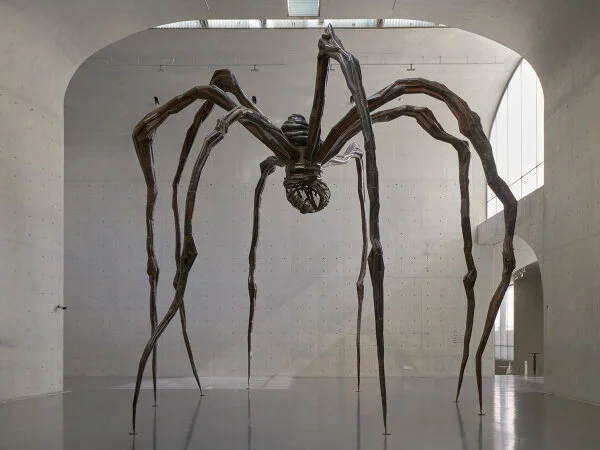Metal
When using metal in my work, it usually for giving a structure to things. My tendency to do analogy between materials and the body is what makes me see metal components as the bones in the body. The bones are the things that stay when all organic elements have been eaten away by maggots. They are also the things our muscles, organs and skin rely on. Without bones - so without a structure - we would collapse. Nothing would be there to support our weight and we would just be floppy puddles of flesh.
Metal wires, nails and hooks are often present in my work, but they are often overlooked because hidden. Something so tiny a nails are enough to put together a whole exhibition, something so thin as a metal wire, is the thing giving shape to an entire sculpture.
Mrinalini Mukherjee, Kusum, Hemp and metal, 1996
Mrinalini Mukherjee makes impressive sculpture using dyed hemp fibers. The first time I saw the work at the Tate Modern, not only I was fascinated by the textures and the wave like movements on her sculptures, but I also thought that the fabric was “free standing”. After doing some research I realized that she actually wove her hemp fibers onto a vertical metal structure that ended up being completely covers by the outer layer, like swallowed whole by a carnivorous plant. Her pieces hold such an organic quality that they almost feel alive. Part flowers, part vulvas, and part monstrous, the metal here really acts like the skeleton of the pieces, disappearing and allowing the magical aspect of the work to be complete.
Mrinalini Mukherjee, Jauba, Hemp and metal, 2000
Jean Tinguely on the other side of the spectrum uses metal as the star of his practice. Being fascinated by machines, gears and impossible contraptions, Tinguely makes the metal sing, dance and screech. Machine (and metal) are usually built and used for a specific purpose but in his case they are more like useless heavy and poetic mechanism. Some draw, some paint, some just are for the simple act of existing, for the sole beauty of “mecha-nism”
One of his most poetic and impactful sculpture was the “auto-destructive machine” a huge machine built only to destroy itself in the process. Tinguely explains this piece in just one sentence “(this machine) it had to be very beautiful, because we had to regret it once it was gone”
Jean Tinguely, La Tour, 1960
Takis, Magnetic fields, 1970
Greek artist Takis, was fascinated by magnetism, and was able to create a certain magic using materials such as metal. In his piece Magnetic fields, Takis transforms this expression into a literal visual metaphore. Little flower magnets are crossed by a bigger magnet and this creates this elecrtomagnetism and makes the flower move, exactly like a flower would dance in a field when being carressed by the wind.
In this case, metal loses its heavy and hard quality to become as delicate and a fragile as an elegant flower.
Make it stand out.
Louise Bourgeois, Maman, bronze, 1999
Imposing, gigantic, heavy, this spider is the symbol of motherhood. It holds paradoxes, and balances between protection and castration, caring and frightening, loving and menacing. When Bourgeois uses metal, she appropriates the imposing and heavy quality of this material and uses as an empowering element, one that weighs and takes space.
“The spider-why the spider?; Because my best friend was my mother and she was thoughtful, intelligent, patient, soothing, reasonable, delicate, subtle, essential, clean, and useful like a spider . She also knew how to defend herself, and defend myself, by refusing to answer embarrassing and stupid personal questions. I will never be tired of representing it. I want to: eat, sleep, chat, hurt, destroy ... -Why? -My reasons are mine alone. "
For me, it's a 'natural' gesture to rip bodies apart, cut them up I always feel that my identity as a woman and as an artist is divided, disintegrated, fragmented, and never linear, always multifaceted always pictures of parts of bodies, fragments and closeups I always perceive the body in fragments. - Annette Messager
Detail of The Pikes
Annette Messager’s use of metal is political. In her installation The Pikes these metal spikes are a direct reference to the principal weapon used to display the guillotined heads of the aristocracy during the popular uprising, known as the Reign of Terror, during the French Revolution.
On the spikes, body parts, ragged dolls, ripped stuffed animals along with pictures of torture instruments and victims. This piece explore the dark face of humanity but also puts in parallel the potential cruelty of children's game (in the cutting and butchering of stuffed animals and dolls) and that of the contemporary history of the work’s creation (with the war images). A certain violence is present in what is shown (the fragmentation of the bodies, the images of war) as well as in the way of showing (the device of the spikes).
Messager mixes in this work, childhood and barbarism in an almost morbid installation. The work challenges us by its theatrical, bizarre (and feminine) side, but it also triggers anxiety and dread. This discomfort is wanted by the artist, who like many artists before, talks about our relationship with the body and death.
Annette Messager, The Pikes, 1992-93






